DEAR FRIENDS. IF YOU LIKE THIS TYPE OF ANALYTICAL CONTENT, SUPPORT OUR WORK:
PayPal: southfront@internet.ru
Donation alerts: https://donationalerts.com/r/southfront
Gumroad: https://gumroad.com/southfront
Or via: http://southfront.org/donate/ or via: https://www.patreon.com/southfront,
BTC: 3Gbs4rjcVUtQd8p3CiFUCxPLZwRqurezRZ,
BCH ABC: qpf2cphc5dkuclkqur7lhj2yuqq9pk3hmukle77vhq,
ETH: 0x9f4cda013e354b8fc285bf4b9a60460cee7f7ea9
Amidst the escalating violence and chaos of the drug wars in Mexico over the last two decades, one group has emerged as the dominant force amongst the numerous cartels and other organized crime and illegal armed groups – the Cartel Jalisco Nueva Generaciòn.
Notwithstanding some important differences, there are also many parallels between the situation with respect the emergence and proliferation of powerful drug cartels and the explosion of related violence, crime and corruption in Mexico and Colombia. From relatively humble beginnings, both countries saw the emergence of a small number of centralized cartels which came to control the lion’s share of the drug trade within a short period of time.
During the 1980s, most of the drug trade in Mexico (mainly marijuana, cocaine and opium at that time), and from there to the US, was controlled by the Guadalajara Cartel under the leadership of Miguel Angel Felix Quintero, who managed to arrange a pact with other groups to avoid competition and disputes. In Colombia the burgeoning cocaine production was almost entirely under the control of the cartels based in Medellin (ostensibly under the leadership of Pablo Escobar) and Cali (headed by the Orejuela brothers) respectively. Towards the end of the decade Mexico became the main transport corridor for cocaine from Colombia to the US, and cooperation between the cartels in each country increased.
Following violent disputes and increasingly successful joint operations against the leadership of the cartels in both countries, from the early 1990s the main cartels were broken up and fragmented into smaller groups which were more difficult to identify and confront. Despite the widely acclaimed successes in capturing or killing the most prominent figures, the overall volume of production and trade of illegal drugs was not significantly affected.
Over time, the main cartels once again grew in size and capacity due to the vast revenues generated, sometimes cooperating to allocate market share, specific activities and regions, sometimes engaging in extremely violent and destructive feuds to take over or eliminate their rivals. In Colombia, the paramilitary groups and insurgent groups came to dominate the drug trade during the 1990s.
Irrespective of whether illicit drug production and distribution has been controlled by a small number of large ‘cartels’ or illegal armed groups or a large number of smaller gangs, overall levels of production and supply have not been significantly affected notwithstanding the vast quantities of resources dedicated to the drug wars by the US and other countries in the region.
US intervention
Around the turn of the century both countries became the front line of the ‘War on Drugs’ waged by successive US administrations, as first Colombia and then Mexico entered into bilateral agreements with the US pursuant to which the US sent military equipment and advisors to each country to combat the production and distribution of illicit drugs. In Colombia, the program for military assistance became entangled with the armed conflict against the main insurgent groups (the FARC-EP and ELN), which at the time controlled large areas throughout the country.
In 2010 Adam Isaacson (Don´t call it a model: On Plan Colombia’s tenth anniversary, claims of ‘success’ don´t stand up to scrutiny) stated of the results ten years after the adoption of ‘Plan Colombia’:
On July 13, 2000, President Bill Clinton signed into law a $1.3 billion package of mostly military aid, known as “Plan Colombia,” that made Colombia by far the biggest U.S. aid recipient outside the Middle East. Now, ten years later, Colombia often gets described as a “success” in Washington. Officials and analysts point to improvements in several measures of security in the conflict-torn South American country. They give the credit to U.S. assistance and to President Álvaro Uribe, who took over in 2002 and implemented a hard-line security policy.
Looked at more closely, though, Colombia’s security gains are partial, possibly reversible, and weighed down by “collateral damage.” They have carried a great cost in lives and resources. Progress on security has been stagnating, and even reversing. Scandals show that the government carrying out these security policies has harmed human rights and democratic institutions. Progress against illegal drug supplies has been disappointing. And wealth is being concentrated in ever fewer hands…
What Colombia has done is worth learning from. But since it favors military force while neglecting both civilian governance and impunity, it is not a model to be applied in Afghanistan, Mexico, or anywhere else. Colombia’s new government and U.S. policymakers face an ever more urgent need to change it.
When U.S. officials praise Colombia, they grade their own work. The United States has spent $7.3 billion on aid to the country since 2000, when Plan Colombia became law. This gives officials a strong incentive to emphasize the positive.
Eight years later, according to official figures, combat has killed 21,000 soldiers, police, guerrillas and paramilitaries. Human rights groups estimate that conflict-related violence killed another 14,000 civilian non-combatants – whether innocent victims or people denied due process – between 2002 and 2008. (Combat not involving the security forces – guerrilla-paramilitary, guerrilla-guerrilla, and paramilitary-paramilitary – probably killed a few thousand more during this period.)
Increasing the security forces’ size and capabilities over 2000 levels, meanwhile, has cost Colombia an additional $40-50 billion over the past decade…
Ten years after ‘Plan Colombia’ was launched Mexico embarked on a similar course, adopting the ‘Merida Initiative’, a joint program largely devised in the US to launch an all-out ‘war on drugs’. The ‘Mérida Initiative’ began during President Calderón’s term (2006-2012), and continued during the presidency of Peña Nieto (2012-2020). The program was described as a bilateral anticrime assistance package, launched in 2008 and initially focused on providing Mexico with hardware, such as planes, scanners, and other equipment, as well as US advisors sent to combat the drug cartels and other illegal armed groups involved in the production and distribution of illicit drugs. The $3 billion effort (through 2018) shifted in recent years to focus on training and technical assistance for the police and enactment of judicial reform, including training at the local and state levels, southern border enhancements, and crime prevention.
As in Colombia, however, without addressing the structural causes of most of the corruption and violence, ‘reform’ programs have not been successful in terms of stemming the illicit drug trade, and the continued reliance on militarization and criminalization of large swathes of society has probably contributed to the extraordinary levels of violence and corruption which still show no signs of levelling off, much less being reduced.
Social and human costs of the ‘War on Drugs’
Beyond the horrific violence unleashed by the cartels and other illegal armed groups against communities where they are most active (typically zones where illicit drugs are produced or important transport corridors, and often also zones of strategic importance or where lucrative natural resources and development projects are located or proposed), they are also inflicting a steadily increasing cost on society in general as their power and wealth reach unprecedented proportions and they become the primary mechanism of social control.
The scale and intensity of violence often peaks when there are territorial disputes between cartels and other illegal armed groups, whether a small number of centralized groups or a large number of fragmented groups (where forging agreements and enforcing their terms is much more difficult). At the same time, however, generalizations can be misleading. Some cartels have deliberately built their reputations and power on terror and acts of the most depraved cruelty and savagery; some have not hesitated to resort to such measures as exemplary punishments and warnings to rivals or potential ‘traitors’, but not as a routine occurrence, and the extent to which violence is used against rivals or as a form of social control varies considerably amongst different groups and over time.
https://twitter.com/LagarrapataS22/status/1273236959016738822
At the same time, however, some cartels have sought to win over the support of local populations, for example through guaranteeing social order in areas where extortion and violence due to smaller gangs is endemic or where other forms of crime impose a heavy cost on the residents. Pursuant to this strategy, they also provide financial support to residents and implement social projects to provide facilities and services to communities abandoned by the State. Pablo Escobar pioneered this strategy in Colombia with considerable success: large parts of the population in Medellin considered him a generous benefactor, and in 1982 he was even elected to the House of Representatives of the national Congress.
The Cartel Jalisco Nueva Generación has been well placed to adopt this strategy, its superior firepower enabling it to annihilate smaller groups in many areas and assume responsibility for imposing social order and control in areas where State security forces are unable or unwilling to do so, its vast revenues enabling it to provide employment, fund community projects and run extensive propaganda campaigns.
In areas where their presence is strongest, cartels and other illegal armed groups have moved beyond controlling the illegal markets as such to controlling every aspect of the lives of the residents in the area, imposing ‘taxes’ on businesses and specific social or economic sectors or transactions and supporting politicians willing to collaborate with them (and brutally murdering those who refuse to collaborate). Their rule is achieved primarily through terror and exemplary punishments or, alternatively, random massacres demonstrating incredible acts of cruelty and brutality to demonstrate their power and impunity and dissuade any thought of resistance or non-collaboration.
In Colombia, the antecedents of such events can be traced directly to the counter-insurgency doctrine, practiced by the Colombian ruling classes in rudimentary form over many years and ‘perfected’ by the US as its direct and indirect participation in Colombia’s social and armed conflict increased, particularly during and since the 1960s. LINK
As with the cartels and paramilitary groups in Colombia, their counterparts in Mexico have also benefited enormously by recruiting extensively from the security forces and infiltrating them directly. Although the links between local and national political and economic elites, landlords and ‘public security forces’ (or private security companies and militias) are not as direct and explicit in Mexico as in Colombia, and tend to be obfuscated by the high levels of more generalized violence, illegality and corruption, in many cases similar trends can be discerned in the sense that acts of exemplary brutality by illegal armed groups designed to terrorize and forcibly displace or control particular communities in rural and remote zones often benefit local and national elites, rarely oppose or confront them, and often take place without the slightest interference by the police or military even in zones where they have been deployed in force.
According to an April 2019 report of the University of San Diego’s Justice in Mexico project:
“The ability of organized crime groups to thrive hinges critically on the acquiescence, protection, and even active involvement of corrupt government officials, as well as corrupt private sector elites, who share the benefits of illicit economic activities.”
In this way, the violence associated with the drug trade (and in Colombia with the long-running armed conflict) overlaps with many traditional sources of disputes, such as over land (typically between landlords and small holders) and natural resources (between companies and rural and Indigenous communities). Invariably the illegal armed groups end up serving the interests of the landlords and agribusiness corporations, usually with cover provided by politicians, police and military personnel.
The state of Guerrero, one of the main regions for opium poppy cultivation in Mexico, provides one example of these overlapping and mutually reinforcing developments. In 2018 Business Insider reported:
Guerrero has consistently been one of the most violent states in Mexico… The number of homicide victims there has risen steadily over the past three years, from 2,016 in 2015 to 2,213 in 2016 and to 2,522 last year, according to government data. With 1,707 homicide victims through August (of 2018), Guerrero is on pace to slightly exceed last year’s total.
The state has a long history of political violence, stemming in large part from land disputes.
Grafted onto that has been drug-related violence, which is stoked both by smaller groups that compete for control of production and other criminal enterprises and by larger groups with a national presence that compete over control of transshipment routes.
Those routes include a valuable overland corridor to Mexico City, which is northeast of the state, and land and maritime routes through Acapulco, which has become one of the most violent cities in the world, nicknamed “Guerrero’s Iraq.” LINK
Such occurrences are facilitated and aggravated by severe human rights violations involving Mexican military and police forces, which at times have colluded with Mexico’s criminal groups. According to a press investigation of published Mexican government statistics, Mexican armed forces injured or killed some 3,900 individuals in their domestic operations between 2007 and 2014 and labelled victims as “civilian aggressors.”
Again, this has parallels in Colombia where the military – pressured to produce ‘results’ by US and Colombian politicians and military commanders, and offered the added incentive of bonus payments and extra holidays – killed thousands of civilians and reported them as being guerrillas killed in combat, known in Colombia as ‘false positives’.
Another parallel with Colombia is the proliferation of ‘forced disappearances’ – in Mexico, the number is estimated at 40,000 (in Colombia there have been approximately 200,000 forced disappearances, though spread over a much longer period of time). As in all cases (such as levels of criminality and corruption in all branches of the State and the private sector, levels of violence and the perpetrators in each instance), there are enormous discrepancies in the available data as accurate information is often impossible to obtain and such information as is available is often camouflaged by misinformation and manipulation of public perceptions.
Homicides and Violence
Both the overall scale and intensity, as well as the nature and objectives, of the violence associated with the cartels, other illegal armed groups and the illicit drug trade have grown exponentially over time.
Drug traffickers in Mexico exercised significant territorial control or influence in most parts of the country located near drug production hubs and along drug-trafficking routes during the six-year administration of President Enrique Peña Nieto (2012-2018), much as they had under the previous president. Although homicide rates declined briefly early in Peña Nieto’s term, total homicides rose by 22% in 2016 and 23% in 2017, reaching a record level. In 2018, homicides in Mexico rose above 33,000, or a national rate of 27 per 100,000 people, about a 33% increase over the record set in 2017. In 2019, Mexico’s national public security system reported more than 17,000 homicides between January and June, setting a new record.
https://www.youtube.com/watch?v=U1xwbbd3b3k
Widespread violence and intimidation directed against Mexican politicians during the 2018 election campaign, and frequent assassinations of journalists, demonstrated the expanding power and ambitions of the cartels and other illegal armed groups. In 2018, some 37 mayors, former mayors, or mayoral candidates were killed, and murders of nonelected public officials rose above 500. In both 2017 and 2018, a journalist was murdered nearly once a month, leading to Mexico’s status as one of the world’s most dangerous countries for journalists.
Mexico’s brutal drug trafficking-related violence over many years has been dramatically punctuated by regular demonstrations of exemplary punishments and displays of wanton violence such as beheadings, public hanging of corpses, car bombs, and murders of journalists and public officials. Along with these brazen crimes, more generalized forms of violence have spread from the border with the United States to Mexico’s interior, particularly in the Pacific states of Michoacán and Guerrero and in the border states of Tamaulipas, Chihuahua, and Baja California, where Mexico’s largest border cities are located.
Cartels as business operations
Drug trafficking organizations (DTOs) have operated in Mexico for more than a century. In their current form, the larger and more centralized DTOs (commonly referred to as cartels) can be described as global businesses with forward and backward linkages for managing supply and distribution in many countries. As businesses, they are concerned with bringing their product to market in the most efficient way to maximize their profits. Over time the dominant groups in Mexico have extended their presence and participation from the main sources of supply (in particular Colombia and the supply routes through Central America) to wholesale and retail distribution, most notably in the US. They have established a foothold in Colombia primarily through agreements with illegal armed groups in the main zones of production and strategic transport corridors.
They have used a variety of tactics to consolidate their presence in the US, as described in a detailed report completed by the Congressional Research Service in 2019 (Mexico: Organized Crime and Drug Trafficking Organizations),
Mexican DTOs are the major wholesalers of illegal drugs in the United States and are increasingly gaining control of U.S. retail-level distribution through alliances with U.S. gangs. Their operations, however, are markedly less violent in the United States than in Mexico, despite their reportedly broad presence in many U.S. jurisdictions.
The DTOs use bribery and violence, which are complementary. Violence is used to discipline employees, enforce transactions, limit the entry of competitors, and coerce. Bribery and corruption help to neutralize government action against the DTOs, ensure impunity, and facilitate smooth operations. The proceeds of drug sales (either laundered or as cash smuggled back to Mexico) are used in part to corrupt U.S. and Mexican border officials, Mexican (and US) law enforcement, security forces, and public officials either to ignore DTO activities or to actively support and protect DTOs. Mexican DTOs advance their operations through widespread corruption; when corruption fails to achieve cooperation and acquiescence, violence is the ready alternative…
As Mexico’s DTOs rose to dominate the U.S. drug markets in the 1990s, the business became even more lucrative. This shift raised the stakes, which encouraged the use of violence in Mexico to protect and promote market share. The violent struggle among DTOs over strategic routes and warehouses where drugs are consolidated before entering the United States reflects these higher stakes. Today, the major Mexican DTOs are poly-drug, handling more than one type of drug, although they may specialize in the production or trafficking of specific products. According to the U.S. State Department’s 2019 International Narcotics Control Strategy Report (INCSR), Mexico is a significant source and transit country for heroin, marijuana, and synthetic drugs such as methamphetamine and to a lesser degree fentanyl destined for the United States…
While drug trafficking remains a core interest and revenues have continued to increase, organized crime groups have also diversified their crime activities, turning to extortion, kidnapping, auto theft, oil smuggling, human smuggling, retail drug sales, and other illicit enterprises. According to the Mexican government’s recent estimates, illegally siphoned oil from Mexico’s state-owned oil company costs the government about $3 billion annually. Many of these activities often have a greater direct impact on local communities in Mexico, and in many cases the DTOs have become the main instrument for the maintenance of some type of social order and control.
The structures and modus operandi of the DTOs
The report completed by the Congressional Research Service in 2019 (Mexico: Organized Crime and Drug Trafficking Organizations) describes some of the consequences of the escalation of the drug war in Mexico in terms of the structures and modus operandi of the DTOs:
Mexico’s DTOs have been in constant flux. Former Mexican President Felipe Calderón (2006-2012) launched an aggressive campaign against the country’s drug traffickers that was a defining policy of his government; the DTOs violently resisted this campaign. By some accounts, there were four dominant DTOs in 2006: the Tijuana/Arellano Felix organization (AFO), the Sinaloa Cartel, the Juárez/Vicente Carillo Fuentes Organization (CFO), and the Gulf Cartel. Government operations to eliminate DTO leadership sparked organizational changes, which increased instability among the groups and violence. Over the past 12 years, Mexico’s large and comparatively more stable DTOs fragmented, creating at first seven major groups, and then nine, which are briefly described in this report. The DEA has identified those nine organizations as Sinaloa, Los Zetas, Tijuana/AFO, Juárez/CFO, Beltrán Leyva, Gulf, La Familia Michoacana, the Knights Templar, and Cartel Jalisco-New Generation (CJNG)…
The most recent splintering of the large DTOs into competing factions and gangs of different sizes began around 2017 and continues today. The proliferation of smaller and more specialized crime groups has made the crime situation even more diffuse and the groups’ criminal behaviour harder to eradicate. Moreover, often the various smaller organizations resist the imposition of agreements to limit violence. The growth of rivalries among a greater number of organized crime and illegal armed groups has produced continued violence, notwithstanding that these smaller and more fragmented groups are “less able to threaten the State and less endowed with impunity.”
The older, large DTOs tended to be hierarchical, often bound by familial ties and led by high profile cartel kingpins. In many cases however they have been replaced by flatter, more nimble organizations that tend to be loosely networked. The larger groups that remain, of which the Cartel Jalisco-Nueva Generación (CJNG) is currently widely reported to be the largest and most powerful, are also increasingly resorting to the outsourcing of certain aspects of production, trafficking and other activities. The ascendency of the CJNG in recent times has been facilitated by the relative decline of the once all-powerful Sinaloa cartel whose notorious chief, Joaquin Guzmán Loera (“El Chapo”), received a life sentence in a maximum-security US prison in July 2019.
The Cartel Jalisco-New Generation
The report completed by the Congressional Research Service in 2019 (Mexico: Organized Crime and Drug Trafficking Organizations) describes the emergence and subsequent expansion of the Cartel Jalisco-New Generation:
Originally known as the Zeta Killers, the CJNG made its first appearance in 2011 with a roadside display of the bodies of 35 alleged members of Los Zetas. The group is based in Jalisco state with operations in central Mexico, including the states of Colima, Michoacán, Mexico State, Guerrero, and Guanajuato. It has grown into a dominant force in the states of the Tierra Caliente, including Guerrero and Michoacán. Reportedly, it has been led by many former associates of slain Sinaloa DTO leader Ignacio “Nacho” Coronel, who operated his faction in Jalisco until he was killed by Mexico’s security forces in July 2010. CJNG has early roots in the Milenio Cartel, which was active in the tierra caliente region of southern Mexico before it disintegrated in 2009. The group is a by-product of the Milenio Cartel’s collapse and was allied with the Sinaloa federation until 2014.
Cartel Jalisco-New Generation reportedly served as an enforcement group for the Sinaloa DTO until summer 2013. Analysts and Mexican authorities have suggested the split between Sinaloa and CJNG is one of the many indications of a general fragmentation of crime groups. Ruben Oseguera Cervantes, alias “El Mencho,” a top wanted fugitive by the DEA, is the group’s current leader. The Mexican military delivered a blow to the CJNG with the July 2013 capture of its leader’s deputy, Victor Hugo “El Tornado” Delgado Renteria. In January 2014, the Mexican government arrested the leader’s son, Rubén Oseguera González (also known as “El Menchito”), believed to be CJNG’s second-in-command. However, El Menchito, who has dual U.S.-Mexican citizenship, was released in December 2014 due to lack of evidence in a federal case. Captured again in late June 2015, El Menchito was again released by a judge. On July 3, 2015, he was rearrested by Mexican authorities; he is being held in the Miahutlan, Oaxaca, maximum-security prison. (He was finally extradited to the US early in 2020.)
In 2015, the Mexican government declared CJNG one of the most dangerous cartels in the country and one of two with the most extensive reach. In October 2016, the U.S. Department of the Treasury echoed the Mexican government when it described the group as one of the world’s “most prolific and violent drug trafficking organizations.” According to some analysts, CJNG has operations throughout the Americas, Asia, and Europe. The group allegedly is responsible for distributing cocaine and methamphetamine along “10,000 kilometers of the Pacific coast in a route that extends from the Southern Cone to the border of the United States and Canada.”
To best understand CJNG’s international reach, it is important to first consider its expansion within Mexico. In 2016, many analysts maintained the cartel had presence throughout the country in a combined area that made up nearly half of Mexico. Recent reports indicate the group has pushed further into Aguas Calientes, San Luis Potosi, and Zacatecas states. The group has battled Los Zetas and Gulf Cartel factions in Tabasco, Veracruz, and Guanajuato, and it has battled the Sinaloa federation in the Baja peninsulas and Chihuahua. CJNG’s ambitious expansion campaign has led to high levels of violence, particularly in Ciudad Juarez and Tijuana, where it has clashed with the Sinaloa federation for control of the lucrative heroin trade and corresponding smuggling routes. The group also has been linked to several mass graves in southwestern Mexico and was responsible for shooting down an army helicopter in 2015, the first successful takedown of a military asset of its kind in Mexico.
CJNG’s efforts to dominate key ports on both the Pacific and Gulf Coasts have allowed it to consolidate important components of the global narcotics supply chain. In particular, CJNG asserts control over the ports of Veracruz, Mazanillo, and Lázaro Cardenas, which has given the group access to precursor chemicals that flow into Mexico from China and other parts of Latin America. As a result, CJNG has been able to pursue an aggressive growth strategy, underwritten by U.S. demand for Mexican methamphetamine, heroin, and fentanyl.
Despite leadership losses, Cartel Jalisco-New Generation has extended its geographic reach and maintained its own cohesion while exploiting the splintering of the Sinaloa organization. It is considered a newer and extremely powerful cartel, based in Mexico’s second-largest city of Guadalajara, and has a presence in 22 of 32 Mexican states. Its reputation for extreme and intimidating violence continues, as well. In August 2019, 19 bodies were found on display in Uruapan in the southwestern state of Michoacán accredited to CJNG, including several bodies that were dismembered and 9 that were hung from an overpass.
A video has recently surfaced (Reclutado por el narco) in which a former member of the CJNG describes the cartel’s training camps and methods in the small town of Talpa de Allende, located in one of the group’s strongholds in the state of Jalisco. According to the informant, the instructors included former members of the security forces of Mexico and the US, explaining the prolific military prowess and capabilities of the group, which has also accumulated powerful arsenals of military grade weapons.
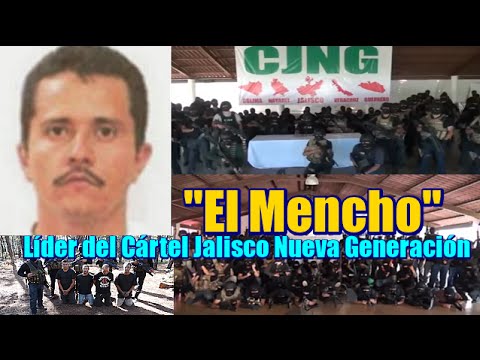
‘El Mencho’, leader of the CJNG
The CJNG is one of three drug cartels that have been targeted by the US authorities to be designated as terrorist organizations, along with the Los Metros faction of the Gulf Cartel (which operates in Reynosa, Tamaulipas), and the faction of Los Zetas called the Northeast Cartel.
The request of the US officials was made during the presentation of a bill to designate the drug cartels as terrorist organizations in which it was claimed that the Jalisco Nueva Generación Cartel, Los Metros and the Cartel del Noreste “meet the criteria for their designation as foreign terrorist organizations, as established in section 219 of the Immigration and Nationality Law.”
Of the three organizations, the case of the Cartel Jalisco Nueva Generación stands out. On October 16, 2018, the US Departments of Justice, Treasury and State announced “coordinated efforts” to combat the criminal organization, which they described as “one of the largest and most dangerous drug cartels currently operating in Mexico”.
In fact, for the Justice Department, “it is one of the five most dangerous transnational criminal organizations in the world, responsible for the trafficking of many tons of cocaine, methamphetamine and heroin with fentanyl to the United States, as well as for violence and significant loss of life in Mexico”.
Another attempt to designate Mexican drug traffickers as terrorists occurred in February of 2019, when Republicans Mark Green and Chip Roy requested that the drug cartels be added to the list of terrorists.
According to Congressman Mark Green of the Republicans, “these cartels have used barbaric tactics, including those adopted by ISIS and Al Qaeda: murdering and torturing innocents, destabilizing countries and assassinating members of the forces of order.” LINK
However, the ability of the US to impose its will on the Mexican government and people has been reduced considerably under Mexico’s new President Andrés Manuel López Obrador who, unlike his predecessors, has defended Mexico’s sovereignty and has clearly said to the US, “cooperation yes, intervention no”.
Lopez Obrador has also stated his belief that the ‘War on Drugs’ has failed, and that it is time to try other strategies such as decriminalization and redirecting the vast amount of resources currently spent on military and police enforcement operations to social and rehabilitation programs. However, it remains unclear exactly how the new strategy will be devised and implemented, and it will still be necessary to confront the out of control violence and corruption and illegal armed groups in the meantime (or perhaps initiate negotiations and public debate to ascertain whether some form of agreement for their demobilization and surrender of arms might be possible, as has occurred in Colombia and Central America on several occasions).
MORE ON THE TOPIC



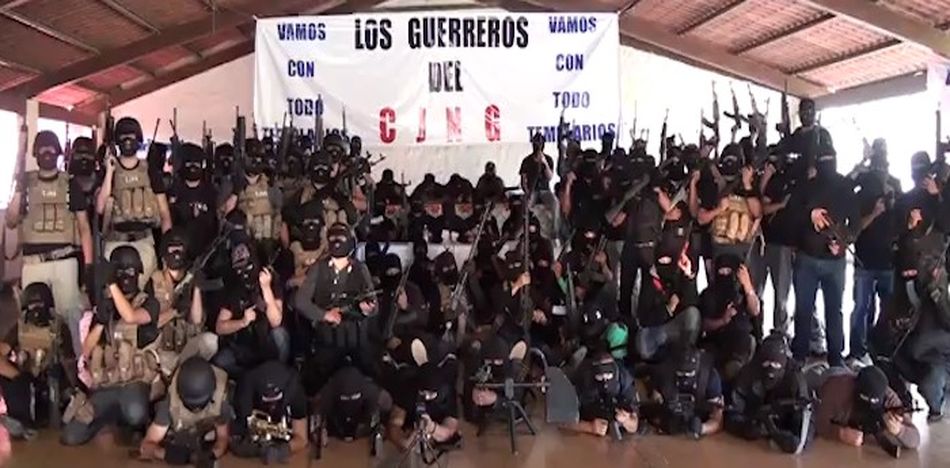
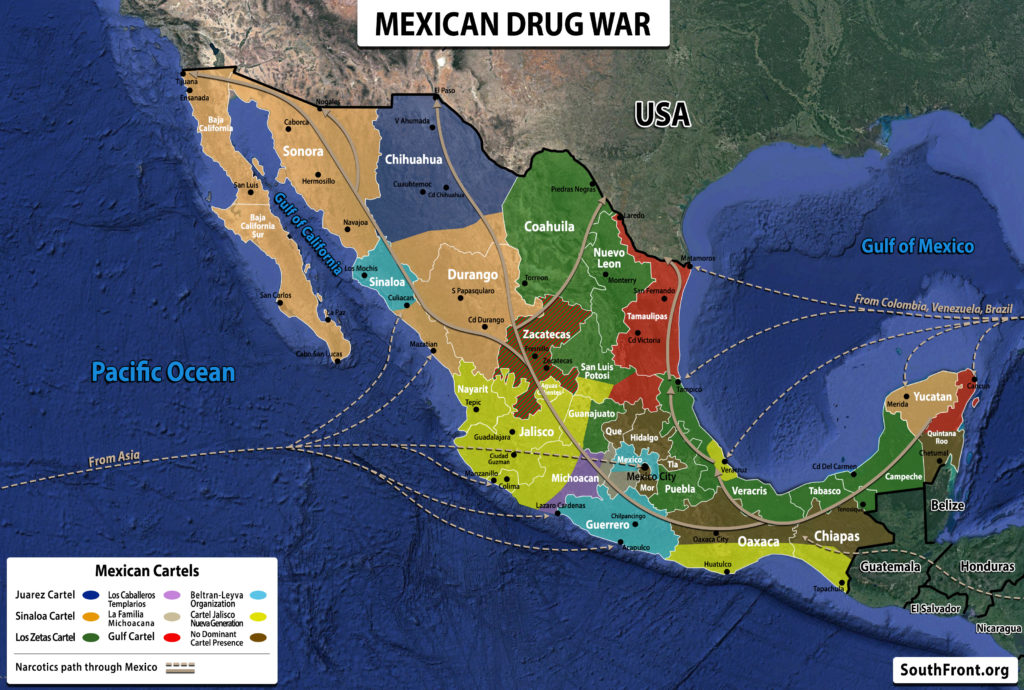
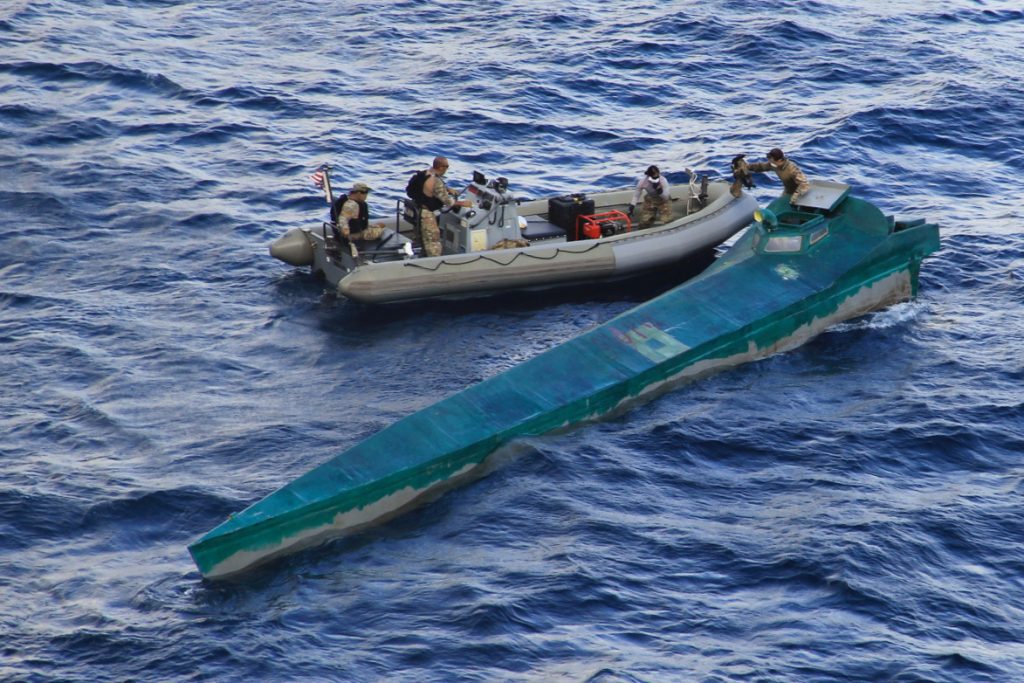
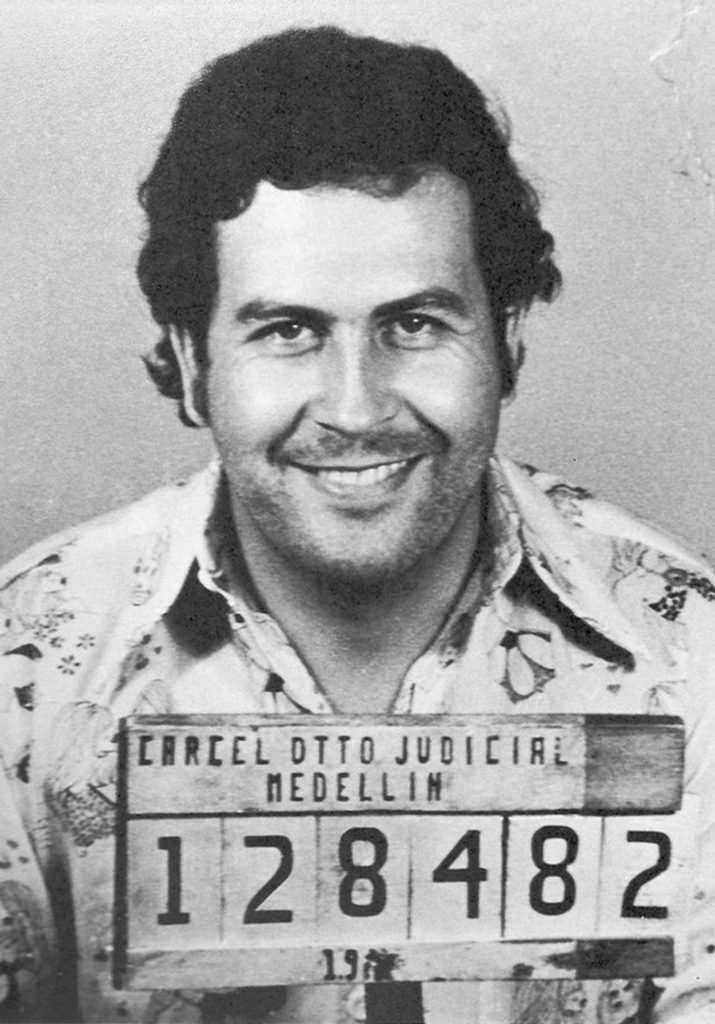
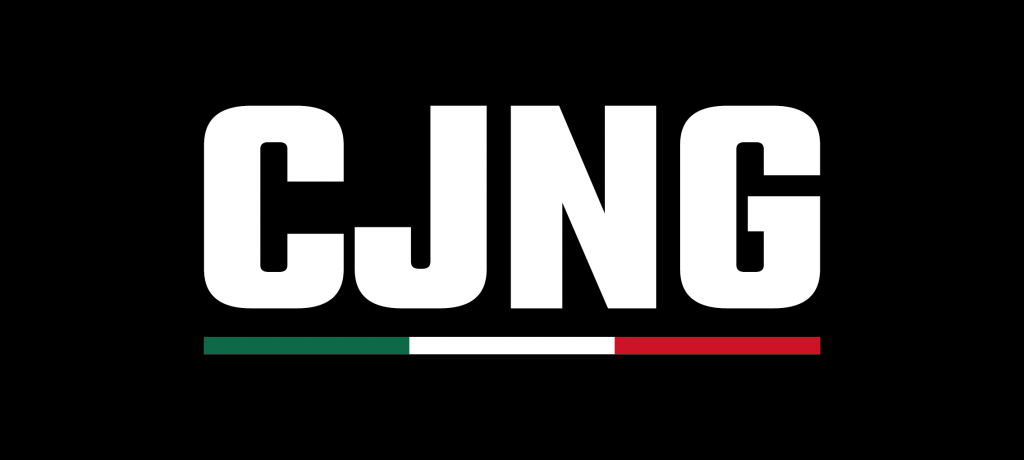

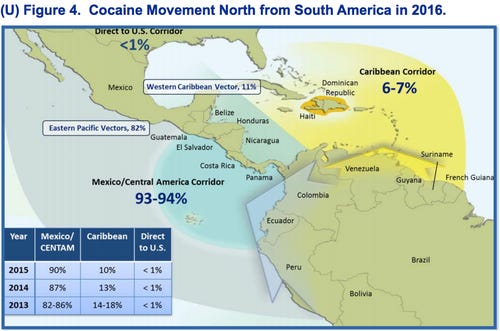



https://southfront.org/wp-content/uploads/2020/06/Mexico_Drug-Routes.jpg
Where is this graphic sourced from? It must be wrong because according to Bill Barr, 99% of illegal drugs come from Venezuela, Cuba, Hezbollah, and Iran.
Barr won’t listen to the DEA apparently
lopitos doesn’t want a fighting against their “friends”, in fact lopitos doesn’t want any responsability
These zio bastards have turned these peaceful countries into narcotics companies
nonsense—amerikan demand creates this discord and violence—jewsaren’t involved in these enterprises
Of course u r right the Jews are not involved in this i never said it was the Jews its the zios who are the enemies of the Jewish people. U said American demand is the Yankee cia zios for sure.
the insatiable American need to narcotize themselves informs this phenomenon. decriminalization would reduce the lucrative nature of these businesses and concomitantly the gang violence. US prisons are populated with petty dealers and users….rarely are the leaders jailed. Little is exported south—it is estimated that 85% is consumed by Americans. Some is exported to Europe mainly through the narco state of guinea Bissau…since plan Colombia the DEA estimates that cocaine production in Colombia has increased 86%…colombia, a veritable US colony is populated by amerikan spies, fake NGO employees, DEA agents and 9 US military installations…Peru and Bolivia produce coca but they are not mired in violence and gang warfare—in S America only the lower classes consume cocaine—perico, charo in Bolivia…polvo, blanco, etc , in Peru Argentina, etc. In Colombia it is ubiquitous, sold by street vendors, taxi drivers, etc, but far more difficult to purchase in Peru, Bolivia, where leaves r sold in markets….central amerikan nations r also effected, especially Honduras, where violence and gangs r ubiquitous–especially Tegucigalpa, san Pedro sula….also Caribbean nations including PR. Bahamas is a known transit nation. the ingenuity of the distributors is legendary—their methods vary and very little is interdicted…amerikan demand drives the industry where a gram costs 60$; the cost in Colombia is 5$, less in Bolivia, a bit more in Peru—except for monolingual tourists where the price is inflated dramatically…the DEA also estimates that amerikans—the largest consumer of illicit drugs per capita consumes 90% of the heroin produced in Mexico and likely all of the meth.
I suspect that amerikan insecurity, anxiety and immorality explains the amerikan requirement to narcotize themselves—this is the inevitable consequence for unhappy sexually repressed people that worship money—always Puritans, amerikans have become more puritanical since the ;puritans wrote, idleness is the devil’s handmaiden —previously it was a misdemeanor in the USA to be idle….Thomas de Zengodita wrote 5 years ago, “busy busy numb–amerikans cannot feel themselves alive unless they feel themselves busy. America is a vast goo of meaningless stimulation”…these puritans even sanction military officers for adultery….”only in Victorial England in western civilization were married women desexualized”. George Simmel… In the USA they dress like grandfathers…..”amerikans are the most prudish people in western civilization: they sublimate their desire by chasing the dollar”. Sigmund Freud…who also wrote, “amerika is gigantic—a gigantic mistake”